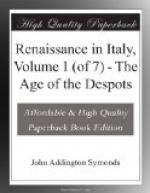CHAPTER III.
The age of the despots.
Salient Qualities of the Fourteenth and Fifteenth
Centuries in
Italy—Relation of Italy to the Empire and
to the Church—The
Illegitimate Title of Italian Potentates—The
Free Emergence of
Personality—Frederick ii. and the
Influence of his Example—Ezzelino da
Romano—Six Sorts of Italian Despots—Feudal
Seigneurs—Vicars of the
Empire—Captains of the People—Condottieri—Nephews
and Sons of
Popes—Eminent Burghers—Italian
Incapacity for Self-government in
Commonwealths—Forcible Tenure of Power
encouraged Personal Ability—The
Condition of the Despot’s Life—Instances
of Domestic Crime in the
Ruling Houses—Macaulay’s Description
of the Italian
Tyrant—Savonarola’s and Matteo Villani’s
Descriptions of a Tyrant—The
Absorption of Smaller by Greater Tyrannies in the
Fourteenth
Century—History of the Visconti—Francesco
Sforza—The Part played in
Italian Politics by Military Leaders—Mercenary
Warfare—Alberico da
Barbiano, Braccio da Montone, Sforza Attendolo—History
of the Sforza
Dynasty—The Murder of Galeazzo Maria Sforza—The
Ethics of Tyrannicide
in Italy—Relation of the Despots to Arts
and Letters—Sigismondo
Pandolfo Malatesta—Duke Federigo of Urbino—The
School of Vittorino and
the Court of Urbino—The Cortegiano of Castiglione—The
Ideals of the
Italian Courtier and the Modern Gentleman—General
Retrospect P. 99.
CHAPTER IV.
The republics.
The different Physiognomies of the Italian Republics—The Similarity of their Character as Municipalities—The Rights of Citizenship—Causes of Disturbance in the Commonwealths—Belief in the Plasticity of Constitutions—Example of Genoa—Savonarola’s Constitution—Machiavelli’s Discourse to Leo X.—Complexity of Interests and Factions—Example of Siena—Small Size of Italian Cities—Mutual Mistrust and Jealousy of the Commonwealths—The notable Exception of Venice—Constitution of Venice—Her wise System of Government—Contrast of Florentine Vicissitudes—The Magistracies of Florence—Balia and Parlamento—The Arts of the Medici—Comparison of Venice and Florence in respect to Intellectual Activity and Mobility—Parallels between Greece and Italy—Essential Differences—The Mercantile Character of Italian Burghs—The ’Trattato del Governo della Famiglia’—The Bourgeois Tone of Florence, and the Ideal of a Burgher—Mercenary Arms P. 193.
CHAPTER V.
The Florentine historians.




